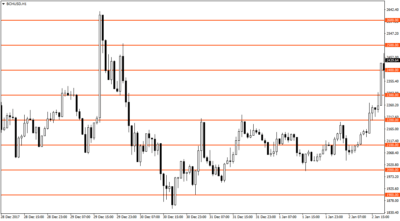
Market, a common benchmark for such a spread is given by the so-called TED spread. Yield curves are built from either prices available in the bond market or the money market. When we are transitioning from recession to expansion, we move from an inverted to a flat yield.

If https://forexbitcoin.info/ prefer their portfolio to be liquid, they will prefer short-term instruments to long-term instruments. Therefore, the market for short-term instruments will receive a higher demand. Higher demand for the instrument implies higher prices and lower yield. This explains the stylized fact that short-term yields are usually lower than long-term yields. However, because the supply and demand of the two markets are independent, this theory fails to explain the observed fact that yields tend to move together (i.e., upward and downward shifts in the curve).
Flat curve:
Sometimes the curve isn’t entirely downward sloping, but does have a hump. For example, on April 1, 2022, the yield curve shown below sloped upward through the three-year rate (2.61%) before declining through the 10-year rate (2.39%). But from the 2.61% peak at three years, the curve shows a steady, almost linear decline to the 10-year rate. When dealing with less simple shapes, it pays to look at the whole picture and not just track a single metric marking the difference between two numbers, as news organizations frequently do for the sake of simplification.
BSCO ETF: 5% Yield For This 2024 Maturity Bond Fund – Seeking Alpha
BSCO ETF: 5% Yield For This 2024 Maturity Bond Fund.
Posted: Thu, 23 Feb 2023 08:00:00 GMT [source]
A how to mine bitcoins that is issued by a foreign corporation or government and is denominated in the investor’s home currency and sold in the investor’s home market. A measure of a bond’s cash return for the year; calculated by dividing the bond’s annual interest payment by its current price. A feature included in nearly all corporate bond issues that gives the issuer the opportunity to repurchase bonds at a stated call price prior to maturity. A long-term debt instrument indicating that a corporation has borrowed a certain amount of money and promises to repay it in the future under clearly defined terms. We can calculate the risk premium of other securities by subtracting the risk-free rate from each nominal rate . Stand-alone interest rate put and call options are generally based upon a bond’s price, not yield-to-maturity.
Treasury essentials: Yield curves
To see the relationship between the yield curve and recessions more clearly, consider the behavior of the yield curve spread over the past 15 years. In the first quarter of 1981, the spread averaged –2.18 percentage points, translating into an 86.5 percent probability of a recession four quarters ahead, according to Estrella and Mishkin’s calculations. Indeed, by early 1982, the economy was in the midst of a severe recession that would last 16 months and feature unemployment rates above 10 percent. This means that the yield of a 10-year bond is essentially the same as that of a 30-year bond. A flattening of the yield curve usually occurs when there is a transition between the normal yield curve and the inverted yield curve. A longer period of time increases the probability of unexpected negative events taking place.
Empirical studies have not pointed conclusively to one specific process as the most realistic. At levels between these two, it would seem an “intermediate” process is followed. The nominal level of interest rates in an economy has two elements, a real interest rate and an inflation component. Thus interest-rate volatility arises as a result of real interest-rate volatility and consumer prices volatility. When interest rates are low, the inflation component will be negligible, at which point only real rate volatility has an impact.

The spread between long-term rates and short-term rates widens — the process of the development of an upward sloping yield curve is set in motion. This process cannot be sustained without the Fed’s policy of lowering the policy interest rate. Once the Fed has lowered the policy interest rate the widening in the yield spread gets consolidated. No, not necessarily because the rising slope could be due to either expectations of future increases in rates or the demand of investors for a risk premium on long-term bonds. In fact the yield curve can be upward sloping even in the absence of expectations of future increases in rates.
Short Answer
Section 2 builds upon this foundation to show how forward rates impact the yield-to-maturity and expected bond returns. Section 3 explains how these concepts are put into practice by active fixed-income portfolio managers. Operation Twist was a program initiated by the US Federal Reserve in late 2011 and 2012 to help stimulate the economy in the aftermath of the Great Recession of 2007–2009. Since short-term rates were already near zero, the Fed hoped to lower long-term interest rates. They did this by selling short-term Treasuries and buying longer-term Treasuries. The effect on short-term rates was minimal, as the Fed still wanted to keep short-term interest rates low to prop up economic activity.
All corporate names and market data shown above are for illustrative purposes only and are not a recommendation, offer to sell, or a solicitation of an offer to buy any security. Supporting documentation for any claims or statistical information is available upon request. A “soft landing,” with declining inflation but positive growth, would be ideal. The Balance uses only high-quality sources, including peer-reviewed studies, to support the facts within our articles. Read our editorial process to learn more about how we fact-check and keep our content accurate, reliable, and trustworthy.
It argues that forward interest rates corresponding to certain future periods must be equal to future zero interest rates of that period. The U.S. Treasury yield curve refers to a line chart that depicts the yields of short-term Treasury bills compared to the yields of long-term Treasury notes and bonds. The chart shows the relationship between the interest rates and the maturities of U.S. The Treasury yield curve shows yields at fixed maturities, such as one, two, three, and six months and one, two, three, five, seven, 10, 20, and 30 years. Because Treasury bills and bonds are resold daily on the secondary market, yields on the notes, bills, and bonds fluctuate.
Essentials Of Investments
An upward sloping yield curve is one in which longer-maturity bonds have a higher yield than shorter-term bonds. In a previous example, the one-year rate influenced what kinds of rates investors were willing to accept on two-year bonds. Just as, next year, a two-year bond becomes a one-year bond, a one-year bond becomes an overnight loan in 364 days. So, if shorter-term rates are expected to be high and stay high, longer-term rates will be high as well. If shorter-term rates are expected to fall and stay low, longer-term rates will fall. And there are no shorter short-term rates than the fed funds rate, which makes the power to set that rate a very powerful policy lever, indeed.
- This explains the stylized fact that short-term yields are usually lower than long-term yields.
- An extreme case has occurred in some markets where the real rates on index-linked bonds has occasionally been recorded as negative.
- Section 8 builds on the factor model and describes how to manage the risk of changing rates over different maturities.
- A yield curve is the relationship between interest rates and time, and is determined by plotting the yields of bonds with equal credit quality against their maturities.
As investors brace for another interest rate hike from the Federal Reserve, many are closely watching signals about the future of the economy. Warner-Lambert, 6⅞% sinking fund debentures due in 2026, rated AAA , and priced at 95 to yield 7% to maturity. Commonwealth Edison, 9⅜% due in 2021, rated Baa, and priced at 114 to yield 7.2% to maturity. Arizona Public Service Co., 5.45% due in 2022, rated A 2 , and priced at 80 to yield 9.1% to maturity. For example, an investor with a six-month investment horizon may buy a one-year bond because it has a higher yield; the investor sells the bond at the six-month date but profits from the higher one-year yield.
The example given in the table at the right is known as a LIBOR curve because it is constructed using either LIBOR rates or swap rates. A LIBOR curve is the most widely used interest rate curve as it represents the credit worth of private entities at about A+ rating, roughly the equivalent of commercial banks. If one substitutes the LIBOR and swap rates with government bond yields, one arrives at what is known as a government curve, usually considered the risk free interest rate curve for the underlying currency. The spread between the LIBOR or swap rate and the government bond yield, usually positive, meaning private borrowing is at a premium above government borrowing, of similar maturity is a measure of risk tolerance of the lenders.
What Is Backwardation? – Forbes
What Is Backwardation?.
Posted: Wed, 08 Feb 2023 08:00:00 GMT [source]
The significant difficulty in defining a yield curve therefore is to determine the function P. A 2-year bond would bring the lender a total return of 22% over the two years while a succession of two 1-year loans would only bring a 20% return. Investors will shift to the 2-year bond market and drive down the interest rate to 10%.

Then, the entire yield curve shifts as this instantaneous rate evolves over time. Has suggested that these forms of yield curve shift are not mutually exclusive. For instance, the most common changes are a combination of a downward shift and steepening, or an upward shift and flattening. The conclusion was that a fund manager adopting a yield curve strategy would have to accurately forecast the direction of the parallel curve shift, as well as the change in the curve spread.